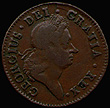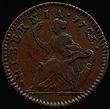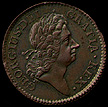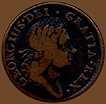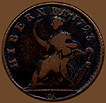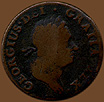Hibernia Copper Halfpence 1722-1724
obverse |
|
reverse |
| |||
1723 [3 over 2] Martin 4-Db Hibernia Halfpenny
Obverse: GEORGIUS . DEI . GRATIA . REX .
Reverse: . HIBERNIA . 1723 .
Weight: 110.8 g (7.18 grams) Diameter: 27.4 mm
Comments: This is a variety of Breen 153. The obverse is the most common form with a central stop above the head. Although the obverse is another example of die 4 note the bust has very long hair ribbons, differing from the other examples presented here. Also there is much less space open between the DEI . GRATIA than in previous examples. Note there is a die crack from the tip of a laurel leaf and through the stop to the upper rim. Another die crack intersects this above the stop and travels to the G in GRATIA. Also in that word there is also a small die crack as a dot between the R and A.
The reverse is the 1723/2 harp to the right version. This variety is easily distinguished by the harp with eleven strings and a date that was originally 1722 changed to 1723. This is the version with the smaller numeral 3, note that most of the 2 is visible to the right of the 3.
Provenance: From the Robert H. Gore, Jr. Numismatic Collection.
obverse |
|
reverse |
| |||
1723 Martin 4-Gc Hibernia Halfpenny
Obverse: GEORGIUS . DEI . GRATIA . REX .
Reverse: HIBERNIA . 1723 .
Weight: 124.0 g (8.04 grams) Diameter: 26.7 mm
Comments: This is a variety of Nelson 8 and Breen 157, Breen mentions there are at least 108 varieties of this combination. The obverse is the most common form with a central stop above the head. This example is struck slightly off center. On the obverse there is a very slight die crack from the top serif of the R to the center crossbar of the A (this hairline is not visible on the scanned image). There is also a large die void under the first leg of the final A in GRATIA and a much smaller void under the chin, close to the neck.
The reverse is the 1723 harp to the right version. It can be identified as die G because it lacks a stop before HIBERNIA and is variant c because it has eleven harp strings and a smaller 3 in the date. There are some small planchet voids on either side of the first I, at the top portion of the B and some below the B in the plain field. There is also a small die crack at the bottom of the E in the date. There is also a dot connecting the third and fourth largest harp strings.
Provenance: From the Robert H. Gore, Jr. Numismatic Collection.
obverse |
|
reverse |
| |||
1723 Martin 4-Hb Hibernia Halfpenny
Obverse: GEORGIUS . DEI . GRATIA . REX .
Reverse: HIBERNIA . 1723
Weight: 113.4 g (7.34 grams) Diameter: 26.1 mm
Comments: This is a variation of Breen 161. The obverse is the most common form with a central stop above the head, however there is less space between that stop and the words than is found in other varieties. The reverse is the 1723 harp to the right version lacking stops before the H and after the 3 in the legend. This type has a harp with eleven strings and, according to Martin, comes in large and small 3 varieties. I suspect this specimen is a large 3 variety. Martin does not cite any photographs for comparative purposes but says an example of the large 3 variety, which was previously unknown, is in his collection. When compared to the 1723/2 small 3 (reverse Db displayed above) the present specimen has a longer top portion for the number, hence I suspect it as the larger 3 variety.
Provenance: From the Robert H. Gore, Jr. Numismatic Collection.
obverse |
|
reverse |
| |||
1724 Martin 4-K Hibernia Halfpenny
Obverse: GEORGIUS . DEI . GRATIA . REX .
Reverse: HIBERNIA . 1724 .
Weight: 104.1 g (6.75 grams) Diameter: 26.0 mm
Comments: This is a variation of Breen 166 and Nelson 11. The obverse of this highly circulated example is the most common form with a central stop above the head. The reverse is the 1724 harp to the right version lacking a stop before the H but including stops before and after the date. This type has a harp with eleven strings and, according to Martin, comes in two varieties. One variety has the legend centered from 9:00 tom 3:00 o'clock while the other has the legend mostly to the left. The present example is the latter variety with the legend mostly to the left. In this example the B in HIBERNIA is at 9:00 o'clock while the 4 is opposite at 3:00 o'clock.
Provenance: From the Robert H. Gore, Jr. Numismatic Collection.
| Hibernia Coppers: p.2 | Section Contents | Spanish Pre-Cobs |
|
For viewing tips and information on optimal computer settings click
here.
For questions or comments contact Special Collections by: |
